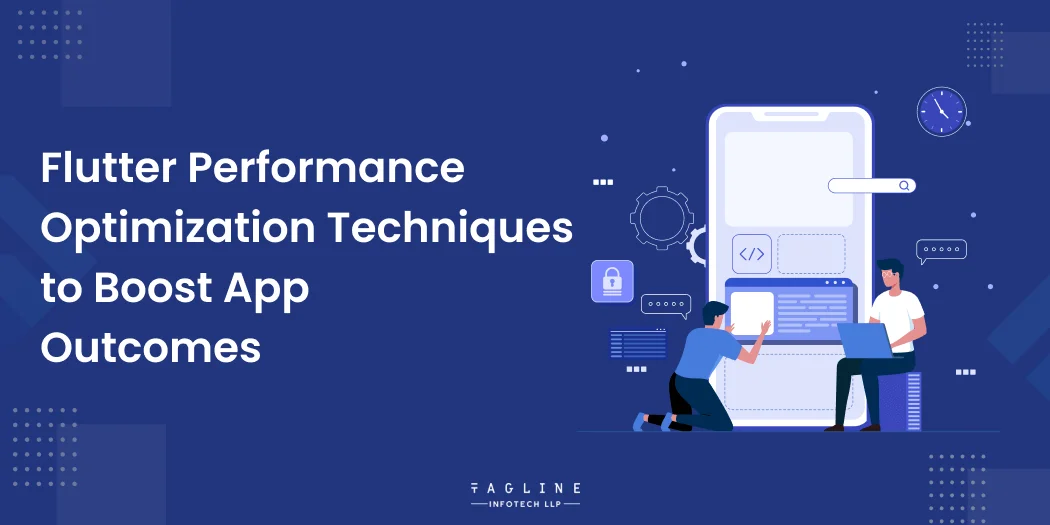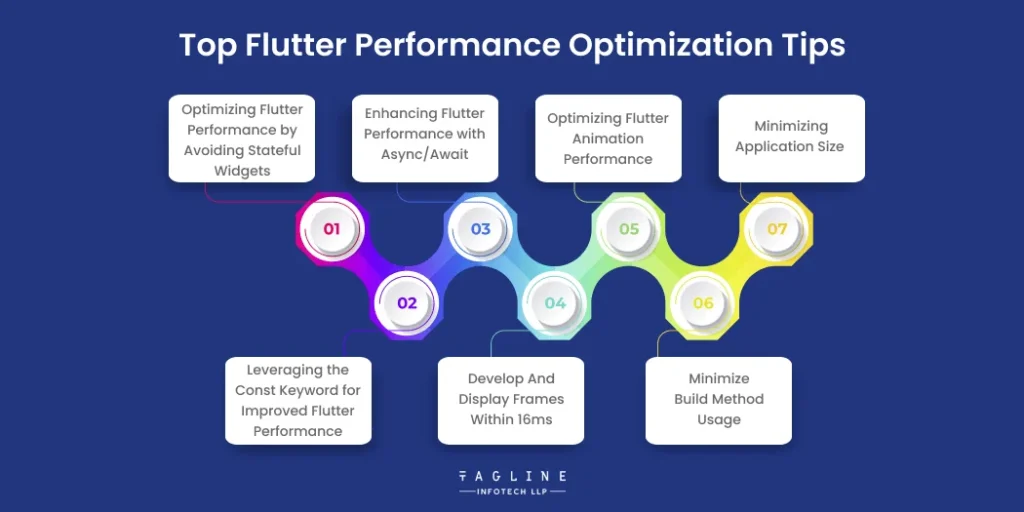Advanced Error Handling in Node.js Applications
December 13, 2024
Home >> Flutter >> Flutter Performance Optimization Techniques to Boost App Outcomes

Quick Summary
In today’s world of mobile apps, making sure your Flutter apps run smoothly is important. Users want apps that work well without any delays or problems. This can make a big difference in how satisfied users are with your app. To achieve this, developers need to focus on improving how their Flutter apps perform. This means using good coding practices, using tools that help monitor how well the app is running, and designing the app’s look and feel in a way that makes it easy to use. By paying attention to these things, developers can make sure their apps work well and give users a great experience.
Introduction
Flutter is now the leading choice for cross-platform app development, leveraging the Dart programming language created by Google. This framework is popular because it cuts development costs and provides the flexibility to build applications for multiple platforms seamlessly. In today’s competitive app market, optimizing Flutter performance is essential. Users expect smooth, glitch-free experiences, which greatly affect their satisfaction and loyalty. Developers must focus on best coding practices, utilize performance monitoring tools, and design user-friendly interfaces to ensure their apps run efficiently and offer a top-notch user experience. By doing so, they can harness Flutter’s full potential to create high-quality applications.
When comparing Flutter and React Native, both frameworks offer impressive performance, but Flutter excels in handling heavy files and memory-intensive tasks efficiently. While React Native apps are typically lighter, they tend to consume more power, which can be a disadvantage in terms of performance.
Flutter’s ability to compile into native code significantly boosts its performance for web and cross-platform applications. Furthermore, Flutter’s tools enhance its versatility, making it suitable for various platforms, including embedded systems like vehicle infotainment systems. By focusing on optimizing Flutter performance, Our Flutter developers can leverage these advantages to create high-quality, high-performing applications across different platforms.

A common mistake in Flutter app development is the overuse of Stateful widgets early in the development process. While Stateful widgets are useful when you need to rebuild large parts of your application, they should be used sparingly.
The `setState()` method and Stateful widgets should be reserved for situations where you specifically need to update or rebuild parts of your UI. Overusing them across entire widgets can negatively impact Flutter’s performance. For better optimization and smoother app performance, it’s advisable to limit the use of Stateful widgets to only the necessary parts of your application.
Utilizing the `const` keyword in Flutter can significantly enhance your app’s performance. The `const` keyword defines a constant value, allowing Flutter to recognize and reuse widgets at compile time rather than creating new instances. This practice helps maintain performance, even when using multiple widgets, by avoiding unnecessary rebuilds.
Benefits of Using Const
1. Optimized Performance: Widgets marked with `const` are instantiated only once, reducing the workload during runtime.
2. Avoids Rebuilds: By using `const`, you prevent widgets from rebuilding unnecessarily, enhancing the overall efficiency of your app.
Use Cases of Const
const EdgeInsets.fromLTRB(16, 4, 16, 8);
const Color lightGray = Color(0xFFFEFEFE);
const Text(‘This is a static text’)
Incorporating the `const` keyword where applicable ensures that your Flutter app runs more smoothly and efficiently, providing a better user experience.
Enhancing Flutter app performance involves judiciously choosing between synchronous and asynchronous code. Async/Await is a powerful tool in Flutter development that allows developers to manage asynchronous operations effectively. By using `async` and `await`, developers can streamline the execution of tasks that don’t need to block the main thread, such as network requests or database operations. This approach not only improves the responsiveness of the app but also enhances its overall efficiency. However, it’s important to balance the use of async/await to avoid unnecessary complexity and ensure that the app remains easy to maintain and debug. By leveraging async/await appropriately, developers can optimize the performance of their Flutter applications, delivering smoother user experiences across various platforms.
Achieving optimal Flutter performance involves efficiently managing frame rendering within a 16ms timeframe. This period is divided into two segments: 8ms for handling the structural elements and another 8ms for rendering the visual content on a 60Hz display.
It’s essential to evenly allocate these 16ms between structural and visual rendering processes to ensure smooth operation and responsiveness in your application.
You might be concerned about whether limiting rendering to 16ms could impact display quality. However, adhering to this timeframe does not compromise visual quality; instead, it can improve the overall battery efficiency of the system. Moreover, maintaining this efficient rendering cycle can enhance performance, particularly on smaller devices where resources may be more limited.
When it comes to adding animations to your web or mobile apps, they can catch a user’s eye. However, animations can sometimes slow down the overall performance of your application.
Typically, developers rely on AnimationController for animations. But when you use AnimatedBuilder, it often leads to multiple widget rebuilds, which can significantly impact Flutter’s performance.
To optimize performance and avoid these slowdowns, consider using CounterWidget. This approach allows you to implement animations without the unnecessary rebuilding of multiple widgets, ensuring smoother performance for your Flutter applications.
Minimizing the use of the `build()` method is crucial for optimizing Flutter performance. This method can be resource-intensive and consume significant CPU power, potentially slowing down your application. To enhance performance, consider breaking down large widgets that heavily rely on the `build()` method into smaller, more manageable components. This approach not only improves efficiency but also ensures smoother operation across your Flutter application.
During development, it’s tempting to incorporate numerous packages, codes, and widgets into your application. However, this can lead to increased memory usage, which can subsequently impact the overall performance of your app.
Flutter provides developers with tools to effectively reduce the size of their applications. By leveraging Gradle, you can optimize your Flutter app’s size to enhance performance.
Google’s packaging system introduces App Bundles, offering several benefits. App Bundles allow developers to create Android application packages tailored to device compatibility and platform architecture. This ensures efficient delivery and installation of applications from the Google Play Store, ultimately optimizing the user experience.
Flutter has been a game-changer in web and native app development, renowned for its robust capabilities in handling applications with intricate visual effects.
To ensure seamless operation and prevent potential errors and slowdowns, optimizing Flutter performance is crucial. Flutter enhances scalability, reliability, and security within your applications. For exceptional Flutter optimization services, consider partnering with Tagline Infotech, a leading Flutter app development company. With expert developers, you can maintain or upgrade your app, boosting performance and visibility while avoiding common pitfalls.
Flutter employs AnimationController and AnimatedBuilder for animations. While animations enhance user experience, improper implementation or overuse can strain performance by increasing CPU and GPU load.
Effective strategies include utilizing const constructors, segregating stateless and stateful widgets effectively, and using keys thoughtfully to reduce unnecessary widget updates and enhance overall performance.
Larger app sizes can lead to longer load times and higher memory usage. Developers can optimize app size by employing techniques like tree shaking, code splitting, and optimizing assets and image compression.
Asynchronous programming with async/await allows Flutter apps to perform non-blocking operations such as network requests and database queries, enhancing responsiveness without freezing the user interface.
Flutter provides tools like Flutter DevTools for profiling metrics such as CPU usage, memory allocation, and frame rendering times. Effective debugging techniques include analyzing widget hierarchies, minimizing rebuilds, and optimizing data handling.
Efficient state management solutions such as Provider, Riverpod, or Redux help minimize unnecessary UI updates and improve app responsiveness. Choosing the appropriate state management approach based on app complexity is key to optimizing performance.

Digital Valley, 423, Apple Square, beside Lajamni Chowk, Mota Varachha, Surat, Gujarat 394101
D-401, titanium city center, 100 feet anand nagar road, Ahmedabad-380015
+91 9913 808 2851133 Sampley Ln Leander, Texas, 78641
52 Godalming Avenue, wallington, London - SM6 8NW